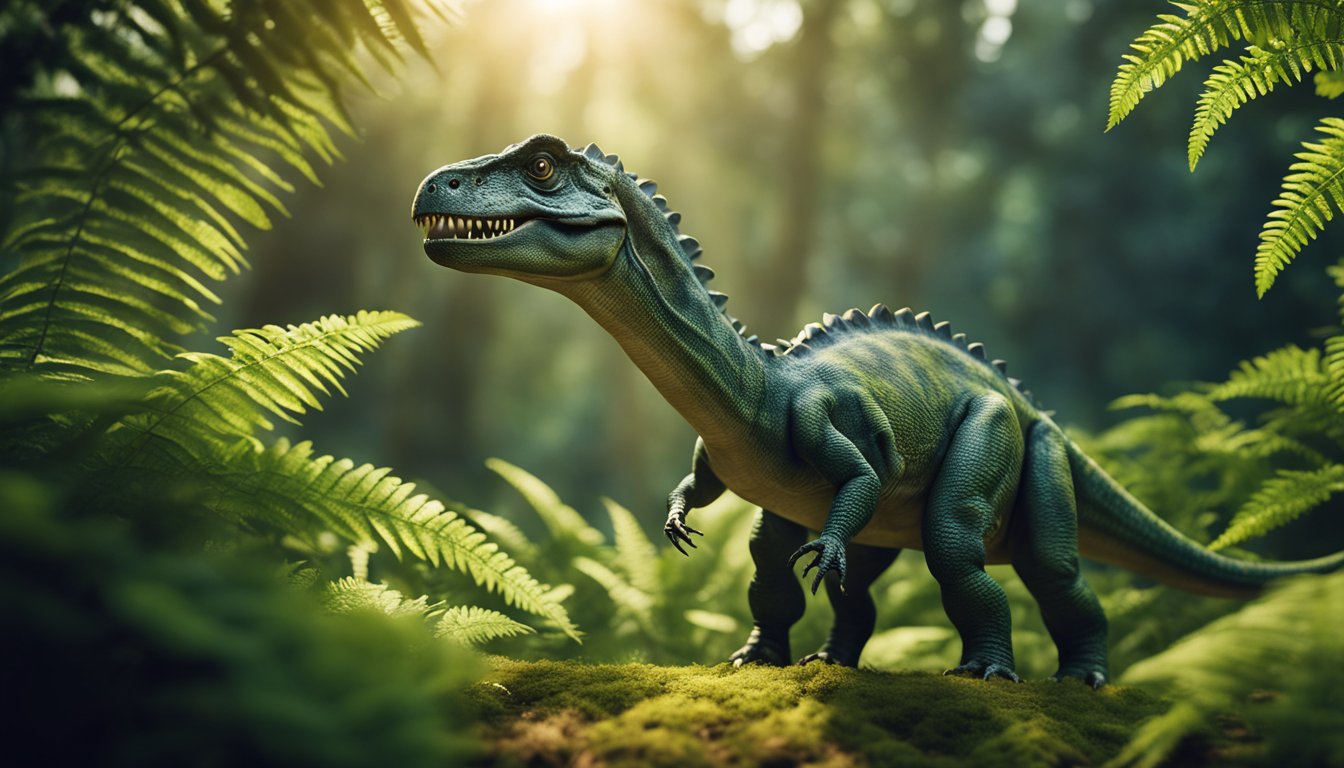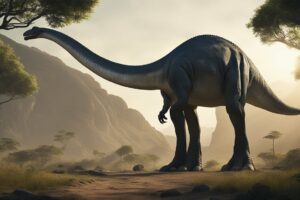Dakosaurus is a prehistoric marine reptile that lived around 150 to 157 million years ago.
It was a fearsome predator that evolved to live almost exclusively in the ocean.
With a length of up to 15 feet and a weight of several hundred pounds, this crocodile-like creature was a force to be reckoned with.

Dakosaurus had a tall and deep skull that earned it the nickname “Godzilla” in popular media.
Its large, jagged teeth and powerful bite could slice through the flesh of other marine reptiles and crunch the shells of ammonites, prehistoric mollusks.
Its paddle-like legs helped it steer, while its fish-like tail pushed it forward.
Dakosaurus was a fierce marine predator that was specially adapted for a life at sea.
Despite being extinct for millions of years, Dakosaurus continues to fascinate scientists and the public alike.
Its unique physical characteristics and predatory behavior make it a fascinating subject of study, shedding light on the evolution of marine reptiles and the natural history of our planet.
Unveiling the Dakosaurus

Meet the Tearing Lizard
The Dakosaurus, also known as the “tearing lizard,” was a marine reptile that lived during the Late Jurassic era, approximately 150 to 130 million years ago.
It was a fearsome predator that roamed the oceans and had a reputation for being one of the top predators in its environment.
The name “Dakosaurus” is derived from the Greek words “dakos,” which means “biter,” and “sauros,” which means “lizard.”
The Dakosaurus was a crocodile-like reptile that was adapted for life in the water.
It had a tall and deep skull that was similar to that of a carnivorous dinosaur, and its large, jagged teeth were perfect for slicing through the flesh of other marine reptiles and crunching the shells of ammonites, prehistoric mollusks.
A Peek into the Past: The Late Jurassic Era
The Late Jurassic era was a time when the Earth was dominated by the supercontinent Pangaea.
The climate was warm and humid, and the oceans were teeming with life, including the Dakosaurus.
During this time, the Mesozoic era was in full swing, and the reptiles were the dominant creatures on the planet.
The Dakosaurus was just one of the many marine reptiles that roamed the oceans during the Late Jurassic era.
Some of the other marine reptiles that lived during this time include the pliosaur, ichthyosaur, and plesiosaur.
These creatures were all adapted for life in the water and were some of the most fearsome predators of their time.
In conclusion, the Dakosaurus was a fascinating marine reptile that lived during the Late Jurassic era.
Its crocodile-like appearance and fearsome reputation make it an intriguing creature to learn about.
By understanding the world in which the Dakosaurus lived, we can gain a better appreciation for the diversity of life that existed during the Mesozoic era.
Anatomy of a Marine Predator
Dakosaurus, the “killer croc” of the Jurassic, was a formidable marine predator with a set of distinctive features that set it apart from other reptiles of its time.
In this section, we’ll take a closer look at its physical characteristics and adaptations for aquatic life.
Distinctive Features
Dakosaurus had a dinosaur-like head with serrated teeth that were perfect for catching and eating fish and other marine animals.
Its sharp teeth were arranged in a way that allowed it to slice through flesh with ease. The long, narrow snout was also well-suited for catching prey.
The reptile had a streamlined body that helped it move quickly through the water. It had four flippers that allowed it to steer and navigate with ease.
Its powerful tail acted like a fish’s tail, propelling it through the water.
Adaptations for Aquatic Life
Dakosaurus had a set of adaptations that allowed it to thrive in the marine environment.
For instance, it had salt glands that helped it regulate the salt content in its body.
This adaptation was particularly useful since the marine environment is salty, and animals that live in it need to be able to get rid of excess salt.
The reptile’s flippers were paddle-like, which helped it steer and move through the water.
Its streamlined body allowed it to glide through the water with minimal resistance.
The combination of these adaptations made Dakosaurus a formidable predator in the marine environment.
In conclusion, Dakosaurus was a fascinating marine reptile with unique physical characteristics and adaptations that allowed it to thrive in the marine environment.
Its dinosaur-like head, serrated teeth, and streamlined body made it a formidable predator, while its salt glands and paddle-like flippers helped it adapt to life in the salty ocean.
Dakosaurus’ Habitat and Diet

Dakosaurus was a prehistoric marine reptile that lived during the Late Jurassic period, approximately 152 to 157 million years ago.
This apex predator of the shallow seas had a unique set of adaptations that made it a fearsome hunter.
In this section, we will explore Dakosaurus’ habitat and diet, including its hunting grounds and prey, and how it became an apex predator of the seas.
Hunting Grounds and Prey
Dakosaurus was a carnivore that fed on fish, squid, and other marine reptiles or smaller marine vertebrates.
Its large, robust jaws with sharp teeth made it a formidable predator that could take down larger prey items.
According to Ocean Info, Dakosaurus had a powerful bite that could slice through the flesh of other marine reptiles and crunch the shells of ammonites, prehistoric mollusks.
Dakosaurus was well adapted to life in the water. Its paddle-like legs helped it steer as its fish-like tail pushed it forward through the water.
Paleontologists believe that Dakosaurus spent most of its life in the water, hunting for prey in the shallow seas that covered much of what is now Europe.
Apex Predator of the Shallow Seas
Dakosaurus was an apex predator of the Late Jurassic period, meaning it was at the top of the food chain in its ecosystem.
Its predatory behavior and feeding habits allowed it to become one of the most efficient hunters of its time.
According to Prehistoric Wildlife, Dakosaurus’ skull and jaws, combined with its large serrated and laterally compressed teeth, indicate that it was a predator of larger prey items.
Dakosaurus was a fearsome predator that ruled the shallow seas of the Late Jurassic period.
Its unique adaptations and predatory behavior allowed it to become an apex predator that dominated its ecosystem.
Fossil Tales and Evolutionary Journey

Discovering Dakosaurus
Dakosaurus was a prehistoric marine reptile that lived around 152 to 157 million years ago.
It was a fearsome predator that evolved to live almost exclusively in the ocean.
The deep skull of Dakosaurus has led to this marine reptile being nicknamed ‘Godzilla’ in the popular media.
However, unlike the famous Japanese daikaiju, Dakosaurus was actually a four to five-meter-long crocodile that was specially adapted for a life at sea.
Its tall and deep skull meant that Dakosaurus was a formidable predator, with a powerful bite that could slice through the flesh of other marine reptiles and crunch the shells of ammonites, which are prehistoric mollusks.
The journey to discover Dakosaurus began nearly 11 years ago as Scott Richardson, a trained volunteer working under Dr. Albright, searched for fossils in the marine sediments of the Tethys Sea.
The Tethys Sea was a large body of water that existed between the ancient continents of Laurasia and Gondwana during the Mesozoic Era.
Richardson’s hard work and dedication paid off when he discovered the first Dakosaurus fossil in the Late Jurassic limestone of southern Germany.
Link in the Evolutionary Chain
Dakosaurus is classified as a member of the family Metriorhynchidae, which belongs to the order Crocodylomorpha.
Metriorhynchids are a group of prehistoric marine crocodylomorphs that lived during the Jurassic and Cretaceous periods.
They were part of a larger group of marine reptiles known as Thalattosuchia, which also included other marine crocodylomorphs, such as Geosaurus.
The discovery of Dakosaurus has provided scientists with valuable fossil evidence that has helped them understand the evolutionary journey of marine reptiles.
Dakosaurus is believed to be a transitional form between the more primitive Geosaurus and the more advanced Metriorhynchus.
Its discovery has helped fill a gap in the evolutionary history of marine reptiles, providing scientists with a better understanding of how these prehistoric creatures evolved and adapted to life in the ocean.
Fun fact: Did you know that Dakosaurus had paddle-like legs that helped it steer as its fish-like tail pushed it forward?
It is fascinating to think about how this prehistoric marine reptile lived and hunted in the ancient oceans.
Frequently Asked Questions

What kind of diet sustained the Dakosaurus during its time on Earth?
The Dakosaurus was a fierce predator that lived during the Late Jurassic and Early Cretaceous periods, around 152 to 157 million years ago.
Its diet consisted mainly of fish, ammonites, and other marine reptiles.
According to DK Find Out, the Dakosaurus had a powerful bite that could slice through the flesh of other marine reptiles and crunch the shells of ammonites.
In which prehistoric period could you find the Dakosaurus roaming the seas?
The Dakosaurus lived during the Late Jurassic and Early Cretaceous periods, around 152 to 157 million years ago.
During this time, the Earth was a very different place, with different continents, climate, and creatures roaming the land and seas.
How large could a Dakosaurus grow, and how does this compare to modern-day marine animals?
The Dakosaurus could grow up to 15 feet long (4.5 meters) and weigh several hundred pounds (100 to 500 kilograms).
While this may seem large, it is relatively small compared to modern-day marine animals, such as the killer whale, which can grow up to 32 feet (9.8 meters) long and weigh up to 22,000 pounds (10,000 kilograms).
Can you describe the physical appearance and distinctive features of the Dakosaurus?
The Dakosaurus was a prehistoric crocodile that was adapted for a life at sea.
It had a tall and deep skull, which led to it being nicknamed “Godzilla” in popular media.
According to Prehistoric Wildlife, the Dakosaurus had large, jagged teeth and paddle-like legs that helped it steer as its fish-like tail pushed it forward through the water.
What modern animals are considered relatives or descendants of the Dakosaurus?
The Dakosaurus is considered a member of the Teleosauridae family, which includes other prehistoric marine reptiles such as the Steneosaurus and the Teleosaurus.
However, there are no modern-day animals that are considered direct descendants of the Dakosaurus.
How is the Dakosaurus different from other marine reptiles of its era?
The Dakosaurus was a unique marine reptile that had a crocodile-like appearance and behavior.
Its tall and deep skull, large teeth, and paddle-like legs set it apart from other marine reptiles of its era.
According to Discover Magazine, the Dakosaurus was a fierce predator that made both fish and pterosaurs fear for their lives.






